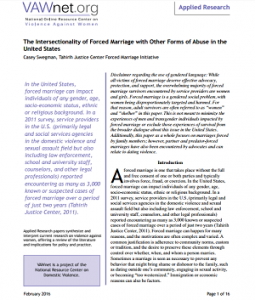“The Intersectionality of Forced Marriage with Other Forms of Abuse in the United States” was written with support from the National Resource Center on Domestic Violence, and I am eager to share it with the world. The paper is a reflection of Tahirih’s many years on the front line of serving individuals facing or fleeing forced marriage in the United States and working in collaboration with advocates and survivors to end this hidden human rights abuse.
Forced marriage is a form of violence against women in its own right, even when sexual violence and other forms of harm and abuse are not present.
When a woman feels she has no real choice when it comes to marriage, she loses a great deal of power and control over her own life. In my work, I have seen the destructive impact of that experience. More often than not, however, forced marriage is just one part of a spectrum of other harms that a woman who is forced to marry may face in her lifetime.
Across the country, there are counselors, advocates, social workers, child protection services, law enforcement officers, and other service providers that touch the lives of women and girls at critical points when intervention could make all the difference.
They have the skills and expertise that can and should be tapped into to serve the complex needs of forced marriage survivors and provide a desperately needed safety net.
This paper is a call for us all to continue to draw connections in our work and to push for an expanded definition of violence against women that recognizes survivors of forced marriage and individuals at risk and provides them with access to the resources and tools to demand and achieve the safety they deserve.
Thank you for reading it and sharing it.

Casey Swegman
Forced Marriage Initiative Project Manager
READ THE FULL PAPER




